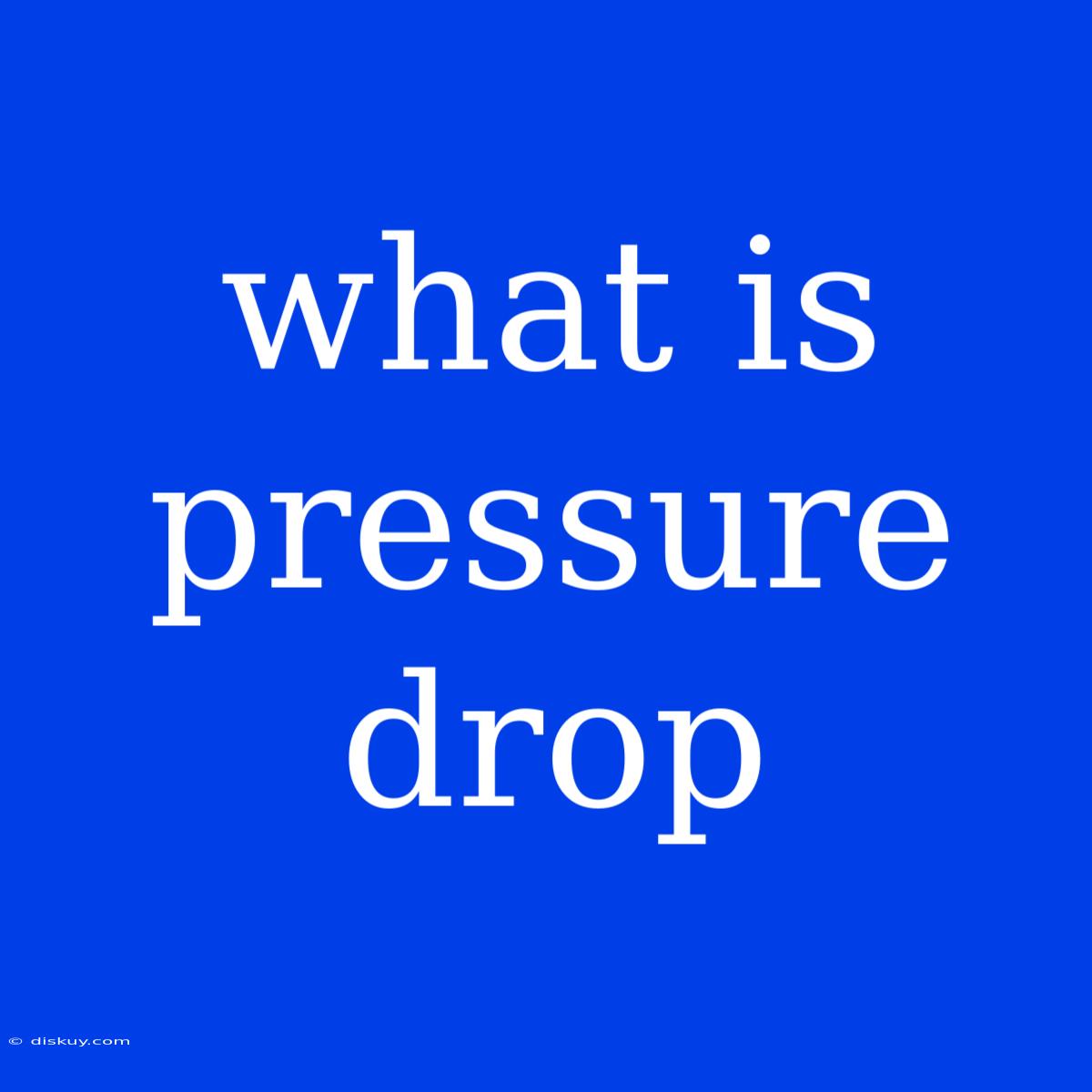What is Pressure Drop: Understanding the Flow of Fluids
What is pressure drop? Pressure drop, also known as pressure loss, is the reduction in fluid pressure as it flows through a pipe, duct, or other conduit. This reduction in pressure is a natural consequence of the friction between the fluid and the walls of the conduit, and any other resistance to flow within the system.
Why is this important to understand? Pressure drop is a critical factor in various engineering fields, especially in the design of piping systems, ventilation, and HVAC systems. Understanding pressure drop allows engineers to:
- Optimize system performance: Properly sizing pipes and equipment to minimize pressure losses and maximize efficiency.
- Ensure adequate flow rates: Calculate the required pump or fan power to overcome the pressure drop and deliver the desired flow rate.
- Prevent system failures: Identify potential pressure drop issues that could lead to reduced flow, component damage, or system malfunction.
Our analysis of pressure drop:
We have delved into various resources and research papers to provide a comprehensive understanding of pressure drop. This guide focuses on its key aspects, their causes, and the factors that influence it, giving you a clear understanding of this vital concept.
Key Takeaways of Pressure Drop:
| Key Aspect | Description |
|---|---|
| Cause of Pressure Drop | Fluid friction against the conduit walls and other resistance within the system. |
| Factors Affecting Pressure Drop | Fluid properties (viscosity, density), flow rate, pipe diameter, roughness, bends, fittings. |
| Importance | Crucial for efficient design, ensuring adequate flow rates, and preventing system failure. |
Understanding Pressure Drop in Detail
Pressure Drop
Pressure drop occurs when energy is lost by the fluid as it overcomes resistance during flow. This lost energy manifests as a reduction in pressure. Imagine a fluid flowing through a pipe. The fluid molecules experience friction against the pipe walls, losing some of their kinetic energy. This lost energy translates into a decrease in pressure.
Key Aspects of Pressure Drop:
Fluid Properties:
- Viscosity: The thicker the fluid, the higher the resistance to flow, leading to a greater pressure drop.
- Density: Denser fluids experience greater pressure drop due to higher momentum loss.
Flow Rate:
- Higher Flow Rates: Increase friction, leading to higher pressure drop.
Pipe Geometry:
- Pipe Diameter: Smaller diameters result in higher pressure drop due to increased velocity and friction.
- Pipe Roughness: Rougher pipe surfaces create more turbulence, increasing pressure loss.
- Bends and Fittings: These create sudden changes in flow direction, leading to additional pressure drop.
Discussion
Pressure drop is a complex phenomenon affected by a combination of factors. Understanding how each of these aspects contributes to pressure drop is crucial for successful engineering design.
Fluid Properties:
- Viscosity: Highly viscous fluids like oil or syrup experience greater pressure drop compared to less viscous fluids like water.
- Density: Denser fluids like gasoline experience more pressure drop than less dense fluids like air, due to higher momentum transfer.
Flow Rate:
- High Flow Rates: Lead to higher velocity and increased friction against the pipe walls, significantly increasing pressure drop.
- Low Flow Rates: Result in lower velocity and less friction, thus reducing pressure drop.
Pipe Geometry:
- Pipe Diameter: Smaller pipes cause a greater pressure drop due to higher velocity and increased contact surface area with the fluid.
- Pipe Roughness: Rough surfaces create turbulence and higher friction, leading to increased pressure drop compared to smoother pipes.
- Bends and Fittings: Sudden changes in direction create additional pressure drop due to the fluid's inertia.
Impact of Pressure Drop:
- Reduced Flow Rate: As pressure drops, the flow rate decreases, which can significantly affect system performance, especially in critical applications like pumping systems and HVAC units.
- Increased Energy Consumption: To overcome pressure drop, pumps and fans need to work harder, leading to increased energy consumption and operating costs.
- Component Damage: Excessive pressure drop can stress pipes, fittings, and other components, potentially leading to premature failure.
FAQ
How is pressure drop measured?
Pressure drop is typically measured in units of pressure, such as pounds per square inch (psi), kilopascals (kPa), or millimeters of mercury (mmHg). It can be measured using pressure gauges installed at different points along the flow path.
What are some common methods to reduce pressure drop?
- Increase pipe diameter: A larger pipe reduces flow velocity and friction, minimizing pressure loss.
- Use smoother pipes: Smooth surfaces create less turbulence and lower friction.
- Optimize pipe routing: Reducing bends and unnecessary fittings minimizes pressure drop.
- Use pressure-reducing valves: These can be used to control pressure drop in specific sections of the system.
Can pressure drop be completely eliminated?
No, pressure drop cannot be entirely eliminated. It is an inherent characteristic of fluid flow due to friction and resistance. However, proper design and optimization can minimize pressure drop to achieve optimal system performance.
Tips to Minimize Pressure Drop:
- Select appropriate pipe materials and diameters: Consider the fluid's properties and flow rate to choose materials and diameters that minimize friction and pressure drop.
- Minimize bends and fittings: Use straight pipe runs whenever possible and employ fittings with minimal flow resistance.
- Use smooth pipe interiors: Choose pipes with smooth inner surfaces to reduce turbulence and pressure loss.
- Ensure proper installation: Properly installed pipes and fittings minimize leaks and unnecessary resistance.
Summary
Pressure drop is a fundamental aspect of fluid flow, influencing system performance and efficiency. Understanding its causes, factors, and consequences is essential for effective engineering design. By carefully considering fluid properties, flow rates, and pipe geometry, engineers can minimize pressure drop and optimize system performance.
Closing Message
The concept of pressure drop extends beyond basic engineering principles and serves as a fundamental building block for understanding more complex fluid mechanics phenomena. By grasping the concept of pressure drop, engineers can design efficient and reliable systems, ultimately improving system performance and minimizing energy consumption.

